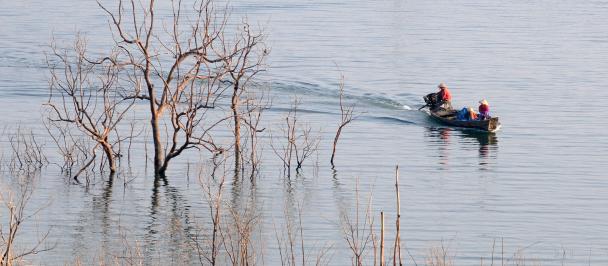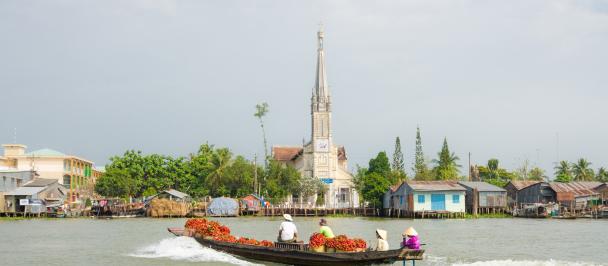Written by Merran Eby, UNDP Viet Nam
‘Now we’ve learned a better approach’: how dragon fruit farmers in Binh Thuan are embracing sustainability in the race to reach global markets
January 28, 2024

Binh Thuan province is famous across Viet Nam for its thanh long, or dragon fruit: outlandish, spiky, and unabashedly bright pink, their dramatic appearance belies their mild, sweet flavour. These are perhaps some of the oddest-looking fruits in existence, and they thrive in the sunny, arid climate of southern Viet Nam, where the weathered farmer Nguyen Van Thanh has cultivated them for years.
Faced with an uncertain economic future and the pressure to modernize, however, he has recently become one of a group of pioneering farmers out to revolutionize dragon fruit production in his community.
“In the past, we grew dragon fruit naturally, sticking to old ways,” he tells us. “Then came the UNDP project in Binh Thuan in collaboration with the Agricultural Extension Centre, offering us training and support.”
An industry under pressure from all sides
Only a few years ago, dragon fruit were a booming business in Viet Nam.
After an extended series of blows, however – including the COVID-19 pandemic’s devastating impact on international trade and a drought in 2020 that prompted the government to declare a state of emergency – the industry was turned upside down. Dragon fruit prices plummeted to a third of their value, while labour costs tripled. Unable to keep up, many farmers who used to tend fields full of these gangly, sprawling members of the cactus family opted to revert to rice cultivation.
Binh Thuan’s dragon fruit farmers have also had to contend with one other growing challenge: many desirable export locations, such as the European Union, Australia, and South Korea, are now placing increasingly stringent demands on the quality, safety, and sustainability of the fruits they import. At the same time, countries like China and India have been drastically increasing their own production of dragon fruit, flooding the market. In an industry where 85 percent of the product is intended for export, business as usual is no longer a viable long-term option.
Sowing the seeds of modernization
The provincial government of Binh Thuan has recognized that the way forward for Vietnamese dragon fruit farmers is not to expand production, but rather to elevate the quality of the farms that already exist.
To do so, they have been collaborating with UNDP Viet Nam since 2019 on a project called “Accelerating Private Sector Engagement in Climate-Resilient and Low-Emission Investment Opportunities in Viet Nam's NDC 2019-2023,” which aims to make the agricultural supply chains for dragon fruit and shrimp greener and more sustainable, including by supporting farmers like Mr. Thanh with modernizing their farms and preparing them to enter the global market for high-quality sustainable produce.
Mr. Thanh’s farm was already certified under Viet Nam’s national Good Agricultural Practice (VietG.A.P.) standards, but he knew that in order to prosper he would need to do more. Determined to absorb whatever he could from the training offered by the project, he attended UNDP workshops offering guidance on meeting the requirements of the most widely recognized international farm certification scheme, GLOBALG.A.P. The training by itself was not enough, however: even after learning about what he needed to do and investing in the new farming methods the UNDP experts introduced, he knew that his fruit still had to pass the test.
In the end, in order for his dragon fruit to be eligible for GLOBALG.A.P., and thereby for export to exacting international markets, Mr. Thanh had to meet more than 900 criteria on waste management, pesticide use, resource efficiency, and fertilizers.
Undeterred, he and his family learned not only how to cut production costs, improve energy and water efficiency, and implement more sustainable farming methods – including by replacing all of his old compact lights with new LEDs, a change which has slashed his electricity costs by around two thirds and relieved pressure on the community’s power grid – but also how to calculate their greenhouse gas emissions and publish their carbon footprint. The project has introduced an e-traceability system that enables a consumer on the other side of the world to scan a QR code and see the entire journey undergone by the fruit they hold in their hands, including data on chemical use, irrigation, and even the type of farm equipment that was used.
Mr. Thanh admits that the lengthy list of requirements involved in meeting GLOBALG.A.P. standards can seem daunting at first, and the initial cost of investment is still deterring some of his neighbours from pursuing certification. He insists, however, that it’s really not that difficult, and mainly calls for time and dedication.
“Once you’ve been trained, putting in the effort is the key to getting the hang of it,” he says. “After being taught, we just need to stay focused and stick to what we learned in order to achieve better productivity, output, and cost efficiency.”
Looking ahead
It took him three tries, but finally Mr. Thanh’s green dragon fruit passed every test. Thanks to the project’s support, his farm has now officially been certified by GLOBALG.A.P., and he is free to pursue lucrative deals with international partners. His perseverance has already paid off: in October, he and his family celebrated exporting their first batches of green dragon fruit to Europe and Australia.
With his own farm’s success as an example, Mr. Thanh hopes that others in his community will soon follow suit.
“Choosing the green dragon fruit trajectory really helps cut down on expenses. In today's world, consumers in international markets tend to favour green dragon fruit products,” he says. “When I can be sure that the dragon fruit I’m holding from my own farm is clean and green, I feel more at ease.”
“For many years we produced dragon fruit in the traditional way,” he reflects, looking out over his fields, “but now we've learned a better approach.”

 Locations
Locations



